Get Creative With Outdoor Perimeter
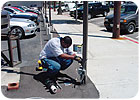
A technician of SummitWatch Inc., Los Angeles, completes a unique wiring system for Crestview Cadillac, West Covina, Calif., under a perimeter beam, a speaker and a video camera on the pole. Photo Courtesy of Summutwatch
Leo Maheux, who has numerous remote facilities, says that about perimeter security, “In the aftermath of 9-11, the security water supply is essential. The perimeter is the first line of defense. “Fences, video, intrusion detection, vehicle, motion, cameras, speakers. Anything that lets us know sooner and speakers and microphones. We want to deter a trespasser.”
The Springfield Water and Sewer Commission in Springfield, Mass., has deployed its intelligent Security Operations Center (iSOC) to assist in the critical work of protecting the water supply for more than 250,000 people.
Tripped Beams Turn on Live Audio/Video System at Central Station
An automobile lot with buildings and three other auto facilities are being protected by a dual-technology volumetric beam system that is integrated with audio/video and is monitored 24 hours a day, seven days a week by a central station.“If somebody trips the perimeter beams, we get an annunciation called priority 7,” explained Hugh Tidwell, vice president of operations for SummitWatch Inc., Los Angeles. “We will get four pictures – three still and one live – of the intruder, and we are immediately talking to them.”
How the intrusion is handled depends on the time of day, Tidwell revealed. The lot at Crestview Cadillac, West Covina, Calif., is monitored from 6 p.m. to 10 a.m. daily. “At 7 a.m., it might be a guy looking for a car on the way to work,” Tidwell conceded.
An announcement is made by the operator, such as, “‘Good morning. Feel free to look. Your actions are being recorded onsite,’” Tidwell recited. “At 2 a.m., they are not looking at cars. We say, ‘This is security. Leave the lot immediately,’ and we call the police.”
The dealerships’ buildings also are monitored with indoor cameras, Tidwell noted. “A lot of our clients have eliminated their burglary and fire alarms because we’re watching the facility,” he reported. “We never recommend that, but some of them choose to make the savings.”
The motion detectors at the perimeter of the parking lots use infrared and microwave technology, Tidwell explained. “There is no way to go over it or under it,” he maintained. “These are volumetric – they have no pattern. They flood the area.
“They don’t create an X or grid or anything you can penetrate,” he insisted. “It is a solid curtain from ground level to 13 feet high. You can set it for the sensitivity to take out birds or cats. We put the beams on the existing light poles on the car lots and cable to the poles.”
The company uses a unique cable installation method. “A lot of companies tear up the asphalt and trench,” Tidwell asserted. “One really unique thing we do is a four-inch grind cut in the asphalt with a diamond-blade slab saw, similar to ones you see on the freeway.
“We lay cable in that and recaulk it so the disruption to the business is minimal,” he noted. “We might have to move a few cars, and then we caulk it and power wash, and you never know we were there.”
Sometimes if the light poles are not positioned properly for the perimeter beams, SummitWatch installs its own 20-foot posts to hold the beams.
When the beams detect an intrusion, day/night pan-tilt-zoom dome cameras zoom in on the intruder and DVRs record the event. The system was installed at the beginning of this year at several facilities that are all under the same ownership, including Crestview Cadillac, another Cadillac dealership, a used car lot, and a remote storage lot.
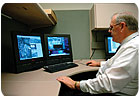
Alarms from fixed-position cameras notify the associated PTZ to track the target. This allows operators to manually call up cameras and control PTZs.
Video Analytics System Employed for Port's Perimeter Security
Video analytics software is used in conjunction with an extensive network of fixed and pan-tilt-zoom surveillance cameras to provide perimeter protection at the Port of Wilmington, Del. The port, one of the busiest on the East Coast, handles more than 400 vessels annually and up to five million tons of cargo.“The port is roughly 300 acres,” according to Eric Schaeffer, owner and president of Advantech Inc., Dover, Del., the project’s integrator. “On its eastern side is the Delaware River and on its northern edge is the Christina River, which meets the Delaware at the northeast point of the port.”
The port has docking facilities for large vessels. “The maximum I’ve seen is three large freight-type ships along the main docking facility,” Schaeffer noted. “Then there’s usually one vehicle-containing ship on the autoberth. These are very large ships holding several thousand vehicles.”
The main entrance is on Terminal Avenue just off I-95. “That’s the main entry and exit point for all cargo haulers,” Schaeffer explained. A railroad spur also serves the port with controlled access.
“Then there are two other vehicle entrances that are typically used for certain types of cargo like heavy materials and also large quantities of vehicles being moved through to the storage lots,” he continued. “All entrances including the railroad entrance are controlled through security management and gate operators.”
On the design end, the manufacturer and video analytics software company were highly involved and on-site. Schaeffer also credited Jim Seningen, a fiber-optic engineer, and Mick Soyka, an electrical engineer, with PEI electrical contractors.
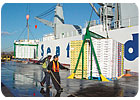
Video analytics software with fixed and PTZ surveillance cameras provide perimeter protection at the Port of Wilmington, Del.
Each video appliance used for the video analytics consists of four processors housed in a chassis. “It’s very processor-intensive,” Schaeffer noted. “We have six-foot racks filled with processors and servers and another rack for digital storage and the server.”
The managers of the Port of Wilmington, the Diamond State Port Corp., requested statements of qualifications to secure the entire perimeter of the port using grant money provided by the Office for Domestic Preparedness (ODP).
Advantech went through an extensive proposal process to obtain the project at the port, where they had secured the main entrance shortly after 9-11. The short list of integrator candidates was evaluated through an interview and presentation process. Advantech and its team scored the most points, thereby winning the project.
The company also had to submit conceptual designs that were fleshed out as soon as they won the project. “It was the entire team,” Schaeffer noted. “It wasn’t us sitting down and designing a solution. It was a true design/build. We had the objectives of what they wanted accomplished, which was a lot, with that round of grant money. We put more into it than we originally thought the budget could support.
“What took a fair amount of time was setting up the perimeter fields-of-view for the video analytics,” Schaeffer reported. “You cover your entire perimeter with fixed-position cameras, and then for interrogation purposes, PTZ cameras are spaced incrementally around the property.”
An alarm from the video analytics software that uses a fixed-position camera will notify the appropriate PTZ camera to track the target, Schaeffer noted. A single interface is used to track activities throughout the facility.
“So if you get an alarm from a fixed-position camera, it will position the associated PTZ to track the target,” he explained. “Activities and alarm conditions are displayed on the wide-area surveillance screen which also allows operators to manually call up cameras and control PTZs.
“Ideally, the operator’s primary function is to acknowledge and react to alarm events,” Schaeffer pointed out. “So if it’s a land-based event or a water-based event, it’s going to highlight the target and display the associated fixed-camera view and use interrogation PTZ to track that target.”
A fiber-optic network was installed throughout the port for communication with the field components. Primary and emergency power needed to be distributed to power these components. “That took a lot of the design end,” Schaeffer noted.
“A lot of these ports are on old reclaimed pieces of land,” he pointed out. “Our team had to be careful. We had to trench a fair amount and used underground radar to make sure we weren’t going to hit something we didn’t want to hit.”
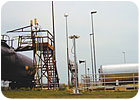
Dual PIR sensors and Doppler microwave detection are used by Ener-Tel Services Inc., San Angelo, Texas, to secure water treatment plants.
Dual Motion Sensors Activate the Video System at Water Plant
Two technologies help eliminate many false alarms, according to Jon Allen Richardson, regional sales manager for Ener-Tel Services.“Without the dual detection, you would end up getting a lot of false alarms,” Richardson conceded. “With dual detection, once it sees both the PIR and Doppler, it automatically goes into alarm, and that reduces the amount of false alarms tremendously.”
The motion detectors were installed by Ener-Tel Services as part of the perimeter security systems at some water treatment facilities in Texas, which are unidentified for security reasons. Mark Perez, manager of technical support and sales for Protech, helped substantially with the application of their sensors to specific sites, Richardson noted.
“On the water treatment plants, some of the problems you’re running into are that they are fairly large areas, and then buildings are scattered throughout that are in the way,” Richardson explained. “There are quite a few blind spots.”
In some areas, up to six dual-technology motion detectors are used and their outputs connected to the inputs on the pan-tilt-zoom cameras. On a square building that has two cameras on opposite corners, the motion detectors can direct the cameras to follow the person all around the building, Richardson noted. The cameras are connected to DVRs that keep a record of any intrusions.
A set-up device on the motion sensors also is handy, Richardson declared. With a special module, a walk-test can be done by the technician. “It can determine when it’s sensing the Doppler or the PIR and it beeps for you, so when you’re setting up, it makes it really easy for the technician in the field to go from detector to detector,” he said.
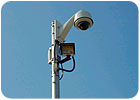
PTZ video cameras and DVRs work on conjunction with the PIR sensors and Doppler microwaves. Operators in the plants’ control rooms are on guard 24/7 to examine any video that is set off by the dual-technology sensors. The two technologies help eliminate many false alarms
Cabling that works by magnetic induction also was used on the fence surrounding such facilities. “It looks like a piece of coaxial cable,” Richardson explained. “It can tell if something is near, if someone is cutting the fence or climbing on it or clipping the wires.”
The wire also can be placed around a gate and sense if it is being tampered with, he points out. The pan-tilt-zoom cameras can be alerted to any intrusion attempts. Wireless transmission at 2.4 GHz is used in some facilities along with a wireless Ethernet backbone. Recently, the company has begun installing fiber-optic cable.
“With wireless, you’ve always got the element of something going down, but with fiber optics, unless your lines are cut, you can depend on it,” Richardson asserted.
“You can almost eliminate lightning surges completely,” he noted, because fiber optic cable is glass. It also does not require an antenna as wireless does, which also can be a target of lightning.
“If you end up with buried copper, even if there isn’t lightning in the area, you always have the potential of a ground difference between the buildings,” he pointed out. “If one building is grounded better than the other, it can pull current through your buildings. So we try fiber between buildings so you have no path for the current to travel at all.”
“We’ve done a little bit of everything,” Richardson declared about his company’s outdoor security projects. “The meat and potatoes is the exterior motion sensors. Those are really what make it happen for you.”
Looking for a reprint of this article?
From high-res PDFs to custom plaques, order your copy today!




